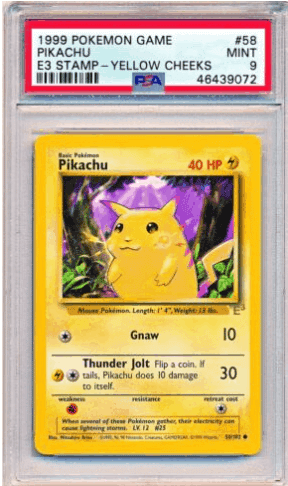Once you start to build up a decent collection of Pokemon cards, you will start to wonder how you can store them and keep them in pristine condition. While there are several methods that you can use, generally speaking, a combination of binders and card sleeves will work well for most people.
If you are storing cheaper cards in bulk, then cardboard boxes will work. On this page, we want to go through the various methods that you can use! Before we dive into the methods for keeping your cards in mint condition, we do want to point out that most Pokemon cards will not actually arrive in mint condition.
The edges can be slightly damaged, and the back of the card may have slight marks on it. So, when we talk about keeping cards in mint condition here, we are mostly talking about ensuring that they stay in the best condition that they possibly can be in.
Card Sleeves
For many, card sleeves are one of the best ways to store Pokemon cards in near-mint condition. You have a few basic options here.
At the lower end of the market, you have penny sleeves. These are very cheap sleeves (cost a penny, as the name suggests!) and will provide small amounts of protection for the card. It won’t stop the card from getting bent, but it will protect the front and the back. This is good for cheaper cards.
Up from this will be slightly heavier duty card sleeves. They can average 5c to 10c each, although there are some more expensive than this. Again, they won’t protect the card from becoming bent, but they can provide adequate amounts of protection for the card. These card sleeves are great if you are planning to play with the cards as opposed to storing them.
We recommend using these Ultra PRO Eclipse card sleeves, from Amazon, for your most used and valuable Pokemon cards. They provide an awesome amount of protection, and double down as one of the best functional cards sleeves for casual and competitive play.
The best form of protection will be top-loaders. These are solid plastic sleeves (similar to a hard case) that can prevent the card from becoming bent. However, it is important that you double sleeve the cards before you put them in. This means putting the card into a penny sleeve and then sliding it into the top-loader. It just means more protection.
Card Binders
Some people store their cards in binders, and others tend to steer clear of them. We can see the argument from both sides.
In the past, binders were an awful way to store your cards. The plastic sheets in binders tended to be poorly designed and made from shoddy materials. This would actually wear down the front of the card. This could cause discoloration. Any cards stored mostly in binders in the 80s and 90s would look awful today.
Thankfully, binders tend to have better quality plastic sheets inside nowadays, so this is not going to be an issue. However, we still would recommend that you steer clear of the cheaper binders. They are still not great.
If going the binder route for card storage, then we only recommend a high quality binder like this one by TopDeck, which you can find on Amazon. TopDeck strives to provide only the highest quality materials as they come from a background of people who love everything trading card.
We wouldn’t really recommend storing high-quality cards inside of binders. There are some people that will double sleeve the cards by adding some penny sleeves on them. This cuts down on a bit of the risk.
The problem with long-term storage in binders is that the edges of the card can become frayed. This is because the binder sleeves start to stretch. Cards can fall out, and cards can be knocked from side to side.
Sure, binders look brilliant, but they are not going to be keeping your cards in mint condition!
PSA Grading
Let’s say that you have an ultra-rare card. Take, for example, a 1st Edition Charizard from the base set when the game was first published by Wizards of the Coast. This card is worth several thousand dollars in less-than-good condition. Upwards of $15,000 in mint condition. This means that you probably wouldn’t want to be storing it using any of the methods here.

Instead, you will want something carried out known as PSA Grading. This is where you ship off the card to the PSA company. They will grade it (from 1 to 10, depending on the quality) and send it back to you in a plastic case. This case will be sealed so the condition of the card is perfect.
You will not be able to sell ultra-rare cards for high value unless it has PSA grading.
It is important to remember that this process is expensive, so save it for the rarest of rare cards. Not your average everyday holo. Not even the cards that seem to have a decent value due to the meta at the time (Tapu Lele GX was valued at $100 for a while, now you can pick it up for $5), but cards that have maintained their value for years, or they are part of a limited edition promo.
This is the ultimate best way to keep your cards in mint condition.
Plastic Deck Boxes
Finally, you can purchase deck boxes. These have been designed to hold 60-120 cards at a time. Make sure that any cards you add into them are sleeved properly as they will be bumping about quite a bit.
Plastic deck boxes are probably going to be the best option for those that are planning on playing with their cards. It makes transportation a little bit easier and helps to protect the cards.
The Pokemon Company does make their own deck boxes, but we find that they are low quality compared to other options. Ultra Pro or Ultimate Guard make some top quality products here, and they are affordable for what you get!
How Do You Store Pokemon Cards in Bulk?
If you have bulk cards, then you have a few storage methods available.
One of the great things about the Pokemon Company is that they tend to sell products that come in decent storage solutions. For example, these products will have somewhere that you can store your cards:
- Trainer Kits (i.e. the ones with several booster packs, energy cards, etc. inside). These are designed to be storage solutions.
- Metal tins with booster packs inside.
- BCW Card Storage Boxes
If you have a browse about some trading card websites, you will also see long cardboard boxes that you can also place your Pokemon cards into. Sure, they are not going to be as thematic as using actual storage products from the Pokemon Company, but at least they are going to be much more affordable.
When storing cards in bulk, put the ones that have an OK value (over 15c) in a penny sleeve, and the rest can just be stored without anything surrounding them, otherwise it becomes expensive.
Remember, always keep your bulk storage out of direct sunlight and out of humid locations. This will ensure the best long-term protection for your Pokemon cards.
To check the current price and availability of BCW Card Storage Boxes, click here to view them on Amazon.
Final Thoughts
If you have extremely rare and valuable cards, consider getting them graded by the PSA to help preserve them for many years to come. This costs money, so it’s really only a good option for extremely valuable cards.
Storing and keeping Pokemon cards in mint condition isn’t that difficult. All you need are some basic supplies, and a bit of knowledge. Obviously, try to ensure that they are always stored in the best sleeves or binders that you can afford.
Alas, try to play with the cards as little as possible if you want to keep them in good condition. The more you touch them, the more they degrade.




